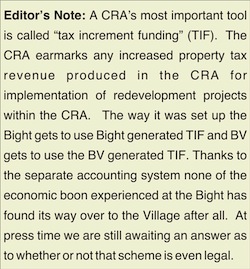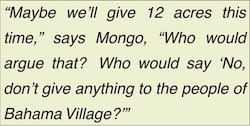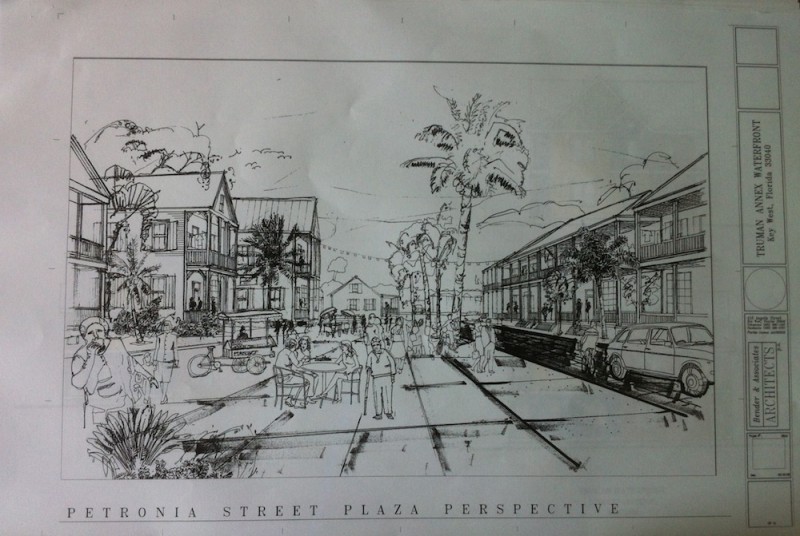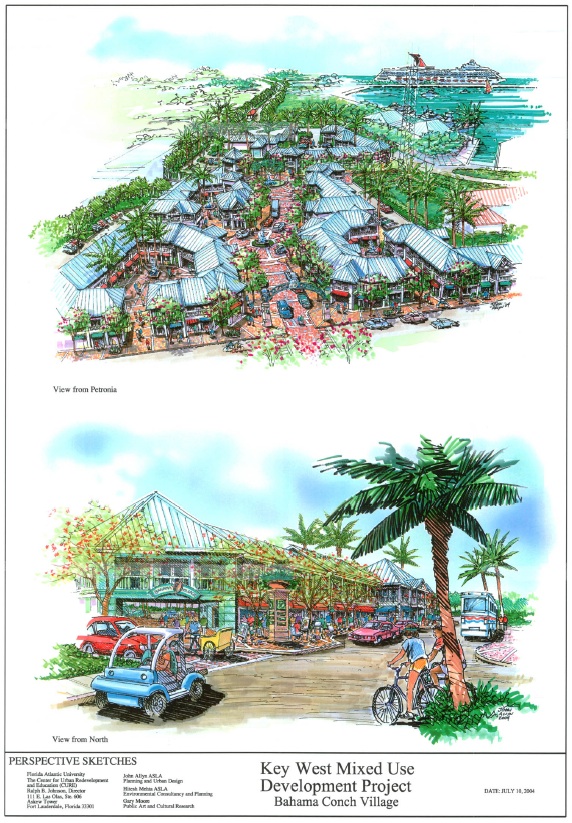by Naja and Arnaud Girard
“The City is derailing a plan which would be good, not just for Bahama Village, but for all of Key West,” says Bob Kelly, a longtime advocate for Bahama Village, Key West’s predominantly black neighborhood, “A vibrant Bahamian community in the Village would be an extraordinary asset to the Key West tourism economy.”
A plan had been designed by local architect Bert Bender for the extension of the Village into the Truman Waterfront, the 33-acre parcel donated to the City by the US Navy in 2002. Bender’s plan was both bold and conventional. It extended the Village’s traditional street grid, but also had some unique features such as green space on the rooftops and mixed commercial space with affordable housing in a single structure.
“I liked all those vegetable gardens on the rooftops, imagine that – in Key West – all those green spaces suspended by the sea. And having a business space at street level and an apartment upstairs,” says Jamaican David, a Bahama Village resident, “that was a real good idea.”
Everyone seems to have liked something about the project.
However, after hundreds of hours of community input and with fully designed architectural plans, the dream of extending the Bahama Village neighborhood into 6.6 acres of the Truman Waterfront looks as though it might remain just that: a dream.
In fact a recent email from Doug Bradshaw, the City’s Project Manager, has brought the issue close to the flashpoint.
“There is no such thing as a 6.6 acre parcel anymore. What remains and what BVRAC discussed was the 2.6 acre parcel that is part of the TIF District,” says Bradshaw in a January 8th email to a member of the Truman Waterfront Advisory Board (TWAB).
Now let us decode those cryptic words for you.
In 2007 a majority of voters approved a referendum reserving 6.6 acres of the Truman Waterfront for the economic benefit of Bahama Village. A non-profit called the Bahama Conch Community Land Trust (BCCLT) conceptualized a vibrant Bahamian community which would offer jobs, small business opportunities, vocational training, affordable housing and recreational space. But apparently, seven years and a whole lot of politics later it seems that the mandate of the people has been lost.
The irony in what some perceive to be a concerted effort to dispossess Bahama Village of its share of the Truman Waterfront is that the Village was one of the main reasons the Navy gave the Truman Waterfront to the City in the first place.
The following is the argument used by the City to convince the Navy to donate this multimillion-dollar waterfront property.
“The redevelopment of the site will enhance the viability of the adjacent Bahama Village neighborhood, both from a quality of life perspective (the residents will no longer be cut off from the waterfront) as well as from a commercial perspective through the creation of up to 339,000 square feet [7.78 acres] of mixed-use space.”
– City’s application to US Navy for free “economic development conveyance” of Truman Waterfront
[Note that at the time, the City was promising 7.78 acres to expand the Village.]
It gets better. When digging into the history of the City’s creation of the Key West Bight Historic Seaport one realizes that again it was Bahama Village that made the acquisition and subsequent redevelopment possible.
That scheme is worth describing in detail. In 1991, the City had just decided to play developer and wanted to buy Key West Bight and develop it into a marina. The problem was that normally a City can’t use taxpayers’ money, including local, state and federal funding, for what are essentially non-governmental purposes like running a marina with shops and restaurants. There is, however, a loophole: Call it a “slum” or “blighted area” and create a CRA (Community Redevelopment Area) and then not only can public money be used for “private purposes” but tons of grants become available, even to private businesses within the CRA.
The City fathers hit a snag though. The survey of buildings and conditions for Key West Bight weren’t going to fit into the state’s requirements for the creation of a CRA. There simply wasn’t enough blight around the Bight, not enough dilapidated buildings, almost no minorities, and not enough ownership diversity. It just wouldn’t work. Then came the stroke of genius: Extend the CRA to include Bahama Village. Suddenly those seeking to justify the creation of a CRA for Key West Bight could capitalize on all of the data showing blighted conditions in Bahama Village. [For instance, where only 25 buildings were found, at the time, to qualify as “deteriorating” in the Key West Bight area, Bahama Village was found to be plagued with 234 such buildings.] It would be called the “Caroline Street Corridor and Bahama Village Community Redevelopment Agency.”
The official justification went like this:
“The theory behind the dual subdistrict was that the potential for the tax increment increasing within the Caroline Street Corridor was much larger than in Bahama Village. The intent was to (…) share the tax increment with Bahama Village, which was in greater need of repair for commercial and residential structures.”
– Bahama Village Redevelopment Plan, 1998 Update, pg 11
Thanks to this very savvy maneuver, grant money would rain on private business at Key West Bight. For example, the “Conch Farm”, claimed it would to be importing thousands of live conch from the Bahamas and promised to create jobs in the “conch-farming industry”. In reality, even at the very top of their ‘conch production’, there would never be more than an aquarium with four or five live conchs, but thanks to the CRA, the famous bar/restaurant would receive over $700,000 of free money from the state for the construction of its parking lot alone!
 And Bahama Village? Well, not long after the CRA was approved, the City Commission decided to use separate accounting for the two neighborhoods; one for the Bight and one for Bahama Village. That move had a cynical result: increasing revenue in the Bight could not [after all] be used to fight the blight in Bahama Village.
And Bahama Village? Well, not long after the CRA was approved, the City Commission decided to use separate accounting for the two neighborhoods; one for the Bight and one for Bahama Village. That move had a cynical result: increasing revenue in the Bight could not [after all] be used to fight the blight in Bahama Village.
“To understand how we feel,” says Clayton Lopez, the Commissioner in whose district Bahama Village lies, “you need to know that for instance the Zero Duval Street property was developed (and granted) on the basis that it was to benefit Bahama Village economically! We can’t, as a City, continue to use Bahama Village as a pretext to reap economic benefit and then ignore the Village after we get what we want.”
Over the course of several years of bureaucracy and politics the initial 7.78 acres destined to provide an economic engine for Bahama Village would become 6.6 acres. A few weeks before the City would sign a 99 year lease with the BCCLT to develop those 6.6 acres, Norma Jean Sawyer, the indefatigable leader of the Bahama Village redevelopment movement would be thrown in jail for having crisscrossed funding from various grants she was supposed to manage and finally, last month, the City announced that the 6.6 acres has completely vanished from the plan.
We sat down with architect Bert Bender who, back in 2009, designed the Bahama Village [6.6 acre] portion of the Truman Waterfront property. Out of the mass of blue prints, elevations and renderings, a remarkably integrated plan materialized. Bender is passionate, almost a Picasso look-a-like. He has put some of his own experience as a kid growing up in inner city Chicago into this urbanization project. It would be hard to miss his disappointment at the lost opportunity, the rare chance for an architect to design more than a facade, and actually have an opportunity to design a better world.
“The main concept.” says Bender, “is the complete integration into the existing street grid: both Petronia and Angela are prolonged all the way to the water.” On both sides of the street we see businesses, artist studios and residential units. We asked Bender if he thinks his plan would still be viable today. “I believe,” Bender says, “that the key to good urbanization, the flow of people, business opportunities, everything, depends on maintaining consistency with the City street grid. And that’s what this plan does – it extends Bahama Village toward the water with more opportunities and integrates well with the existing neighborhood. I believe the plan is as good today as it was when it was designed a few years ago.”
“I don’t see any reason why we should not keep going with Bender’s plan,” says Lopez. “The 6.6 acres is still very much on the table. I’ve asked for a joint meeting of BVRAC (Bahama Village Redevelopment Advisory Committee) and TWAB to discuss the 6.6 acres and it needs to happen soon.”
“The biggest misconception,” says Wendy Coles, former executive director of SHAL (Southernmost Homeless Assistance League), is to believe that Key West has to give up some land for Bahama Village or that Bahama Village is taking from the rest of the community, when really it is absolutely obvious that it is in the best interests of the City as a whole to foster a vibrant Bahamian Community… Just creating more affordable housing is not ambitious enough. We need to create opportunity for full development of a unique neighborhood with its specific culture, food, and services. That would be a tremendous asset to everyone in the City.”
 “Bottom line,” says Mike Mongo, one-time mayoral candidate, “the mandate of the people was clear: the majority of voters said, ‘give Bahama Village residents control of a fair share of the waterfront.’ The Commission should realize that voters were not concerned about who Norma Jean Sawyer or the BCCLT were. What we said was, ‘Give 6.6 acres to the people of Bahama Village.’” Mongo also says, if necessary, there could be a new referendum. “Maybe we’ll give 12 acres this time,” says Mongo, “Who would argue that? Who would say ‘No, don’t give anything to the people of Bahama Village?’”
“Bottom line,” says Mike Mongo, one-time mayoral candidate, “the mandate of the people was clear: the majority of voters said, ‘give Bahama Village residents control of a fair share of the waterfront.’ The Commission should realize that voters were not concerned about who Norma Jean Sawyer or the BCCLT were. What we said was, ‘Give 6.6 acres to the people of Bahama Village.’” Mongo also says, if necessary, there could be a new referendum. “Maybe we’ll give 12 acres this time,” says Mongo, “Who would argue that? Who would say ‘No, don’t give anything to the people of Bahama Village?’”
It is hard to imagine who would want to stand in front of that train.
Stay tuned.
~~~~~~~~~~~~~~~~~~~~~~~
BELOW: A rendering by John Allyn, Florida Atlantic University, Center for Urban Redevelopment and Education, 2004


Sorry, the comment form is closed at this time.